Martin & Mandy

Over the next six weeks we strim and clear all the weeds and nettles from the graveyard and inside the Nave, revealing surprising things along the way, and we eventually discover that there is a stone aisle still in place. Finally the nave is transformed by the removal of five van loads of undergrowth, earth and rubbish. Then on the outside of the church we remove all the ivy that is clambering over the stonework and fully reveal the beauty of the checkerboard effect you can see at the base of the tower.
After all this, backs aching, and nails broken (well Mandy’s nails are anyhow) we decide to do some indoor work instead, and head off down to the Hertfordshire archive offices. Down at the archive, we do a different kind of unearthing of surprises, all about the memorials in the chancel - the Butt Family, the Crouch Family, and Robert Wogdon. We find records created by chaps called Clutterbuck and Gerish which show the colours of the memorials as they were 100 years ago along with sketches of the church and surrounding area from that time.
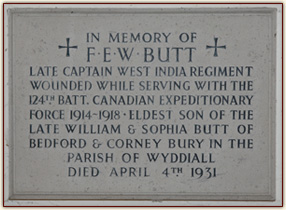 One of the Butt’s in the chancel is F.E.W. Butt, at least that is what is engraved on the memorial, a Captain in the West India Regiment and part of the Canadian Expeditionary force from the 1914-1918 war. It’s just on the right on your way into the Chancel.
One of the Butt’s in the chancel is F.E.W. Butt, at least that is what is engraved on the memorial, a Captain in the West India Regiment and part of the Canadian Expeditionary force from the 1914-1918 war. It’s just on the right on your way into the Chancel.
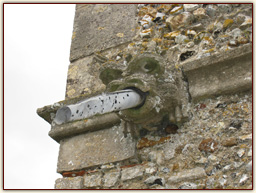 Amongst other things too numerous to mention we find his sign up papers for the Army for the Great War although he signed up for the 255th battalion rather than the 124th mentioned on the memorial. Another mystery also popped up in guise of his brother Herbert who we had found no mention of up to now. Frank, that’s the F in F.E.W., emigrated to Canada after leaving the West India Regiment and became a farmer. Herbert we have since discovered lived in Santa Fe in Argentina - and all this from one small memorial.
Amongst other things too numerous to mention we find his sign up papers for the Army for the Great War although he signed up for the 255th battalion rather than the 124th mentioned on the memorial. Another mystery also popped up in guise of his brother Herbert who we had found no mention of up to now. Frank, that’s the F in F.E.W., emigrated to Canada after leaving the West India Regiment and became a farmer. Herbert we have since discovered lived in Santa Fe in Argentina - and all this from one small memorial.
Mandy and I have now got the nave clean and weed free and it’s time to get the building laser scanned. When you are drawing plans up for a building you can start by getting a tape measure out and measuring everything item by item, or you can use a laser scanner to measure the entire building. A laser scanner produces a map of the building in a computer that has the details of absolutely every single piece of stone and lime plaster down to within a millimeter accuracy and this is what we have done.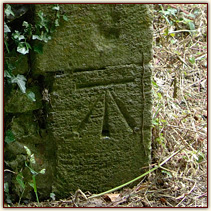
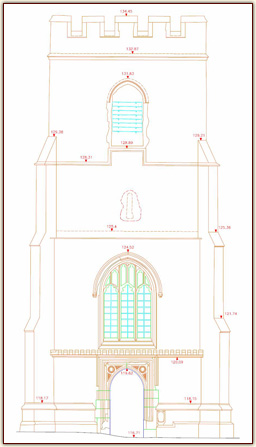 The advantage of this approach is that we get a historical record of exactly what is there, a wild 3D model of St Bartholomews on my computer and a full set of 2D diagrams all ready for an architect to work with.We also get an understanding of the general condition of the building - for example we can see that there is not a straight wall in the whole place! There are some alarming bows to the North wall of the Nave but I just ignore these for the time being - we shall deal with this when I have a structural engineer on the project. The next surprise is that the church is not quite square on the points of the compass... It’s only a degree or two out and so not bad at all for 11th century builders, as it’s taken all this time and a lot of modern technology to work this one out. And finally buried under all the ivy we uncover an Ordinance survey trig mark on the base of the South West corner of the tower - next time your walking past the tower have a look for it - you can’t miss it now.
The advantage of this approach is that we get a historical record of exactly what is there, a wild 3D model of St Bartholomews on my computer and a full set of 2D diagrams all ready for an architect to work with.We also get an understanding of the general condition of the building - for example we can see that there is not a straight wall in the whole place! There are some alarming bows to the North wall of the Nave but I just ignore these for the time being - we shall deal with this when I have a structural engineer on the project. The next surprise is that the church is not quite square on the points of the compass... It’s only a degree or two out and so not bad at all for 11th century builders, as it’s taken all this time and a lot of modern technology to work this one out. And finally buried under all the ivy we uncover an Ordinance survey trig mark on the base of the South West corner of the tower - next time your walking past the tower have a look for it - you can’t miss it now.
The down side of all this technology is that it’s quite expensive, we needed to hire a cherry picker as well so we can position the laser scanner above the building but we will be able to get aerial pictures of the building as part of the activity. So the day comes and the contractors arrive along with the cherry picker. They spend a couple of days working on the building scanning everything inside and out.I pay a visit to site on the second day and get to see the outside of the tower roof. Mandy,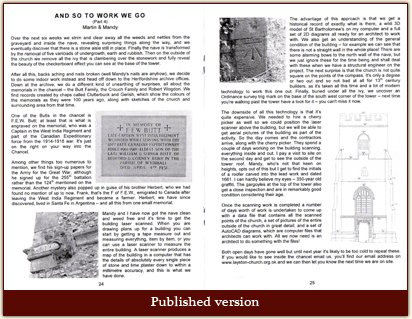 who’s not that keen on heights, opts out of this but I get to find the initials of a roofer carved into the lead work and dated 1661... I can hardly believe my eyes - 350 year old graffitti. The Gargoyles at the top of the tower also get a close inspection and are in remarkably good condition considering their age.
who’s not that keen on heights, opts out of this but I get to find the initials of a roofer carved into the lead work and dated 1661... I can hardly believe my eyes - 350 year old graffitti. The Gargoyles at the top of the tower also get a close inspection and are in remarkably good condition considering their age.
Once the scanning work is completed a numbers of days worth of work is undertaken to come up with a data file that contains all the scanned points of the church, a set of pictures of the entire outside of the church in great detail, and a set of Autocad diagrams which are computer files that architects can work with. All we now need is an architect to do something with the files!
Both open days have gone well but until next year it’s likely to be too cold to repeat these. If you would like to see inside the Chancel email us, you’ll find our email address on
www.layston-church.org.uk we can then let you know the next time we are on site.
 |
|
 |
